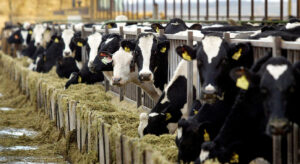THE National Dairy Authority (NDA) said it proposed a P1.2-billion budget for 2024, mainly to import dairy cattle and develop stock farms.
“The plan is to bring in animals then we will breed them in stock farms, so that we are able to distribute island-born (cattle) to farmers,” NDA Administrator Gabriel L. Lagamayo told BusinessWorld.
The proposed funding will finance the import of 2,000 dairy cattle and develop two stock farms.
Philippine production is equivalent to only 1% of its milk demand and needs to import the rest.
“In the past years, tumataas naman ’yong production, ’yon nga lang, the demand exponential ang increase na hindi kayang habulin ng production (Production has been rising, but demand has been rising at an exponential rate. Domestic production cannot keep up),” he said.
The US Department of Agriculture projects Philippine demand to increase 3% to three million metric tons (MT) in liquid milk equivalent this year.
According to Mr. Lagamayo, the Philippines’ main dairy suppliers are the US, New Zealand, and Australia.
He projects dairy production of 32 million MT this year from 30 million MT previously, aided by the herd buildup.
“We don’t have enough dairy animals to do that. Hindi sa atin likas ang — kung meron man tayong native, may gatas nga, pero at the end, gaano karami naman? (Dairy production has not really taken hold — whatever native dairy animals we have are not enough). Whereas, if we invest in dairy animals or we try to cross breed our native cattle to dairy animals, pwede ’yon (we might be able to do it),” he said.
The Philippine Statistics Authority estimates the herd of dairy animals at 70,995 head in the nine months to September 2022.
Dairy cattle accounted for 52% of the milk produced by volume from 23,745 head.
The registered herds of dairy carabaos and goats numbered 17,299 and 29,851, respectively.
For this year, Mr. Lagamayo said 2,000 dairy animals from Australia are under quarantine, part of the 3,700 shipment of imported animals that will be distributed to farm owners.
Beneficiaries will be evaluated to determine what improvements they require in facilities, animal feed, and know-how.
The NDA will also propose dairy farm owners to organize cooperatives to maximize feed usage.
“The farmers need to work together,” Mr. Lagamayo said.
Julius C. Velasquez, a dairy farm owner in Norzagaray, Bulacan, said he and his fellow farm owners plan to establish an association.
“Ang nangyayari po kasi, hindi nila binibigay ’yung kambing sa mga gustong magsimula. Nauuwi rin po sa malalaking farm. ’Yong mga gusto rin mag-alaga, hindi sila magkaroon (The people who want to start dairy farming are not receiving goats, but the big farms get them. The ones who want to start raising goats don’t get any),” he told BusinessWorld via phone.
Mr. Velasquez owns 18 Anglo-Nubian goats which were imported from the US. He shifted away from native goats before the coronavirus disease 2019 (COVID-19) pandemic.
He said each registered doeling (immature female goat) costs between P50,000 and P70,000, while unregistered animals fetch P30,000.
“If there are many (customers) looking, (we) will earn a lot. If there is a lot more milk to source out, the (dairy animals) can provide for themselves as the income will also be used for their food and maintenance,” he said.
According to Mr. Lagamayo, the daily average milk production per farm is 8-10 liters, which may be improved to 15-16 liters through better feed quality a cooperative will have access to.
He said that the NDA aimed to teach farmers the proper way of making corn silage to minimize losses and to promote farm collaboration in feed production.
“If farmers produce their own feed, it would be easier for the next farmer to enter dairy farming,” he said. — Sheldeen Joy Talavera
